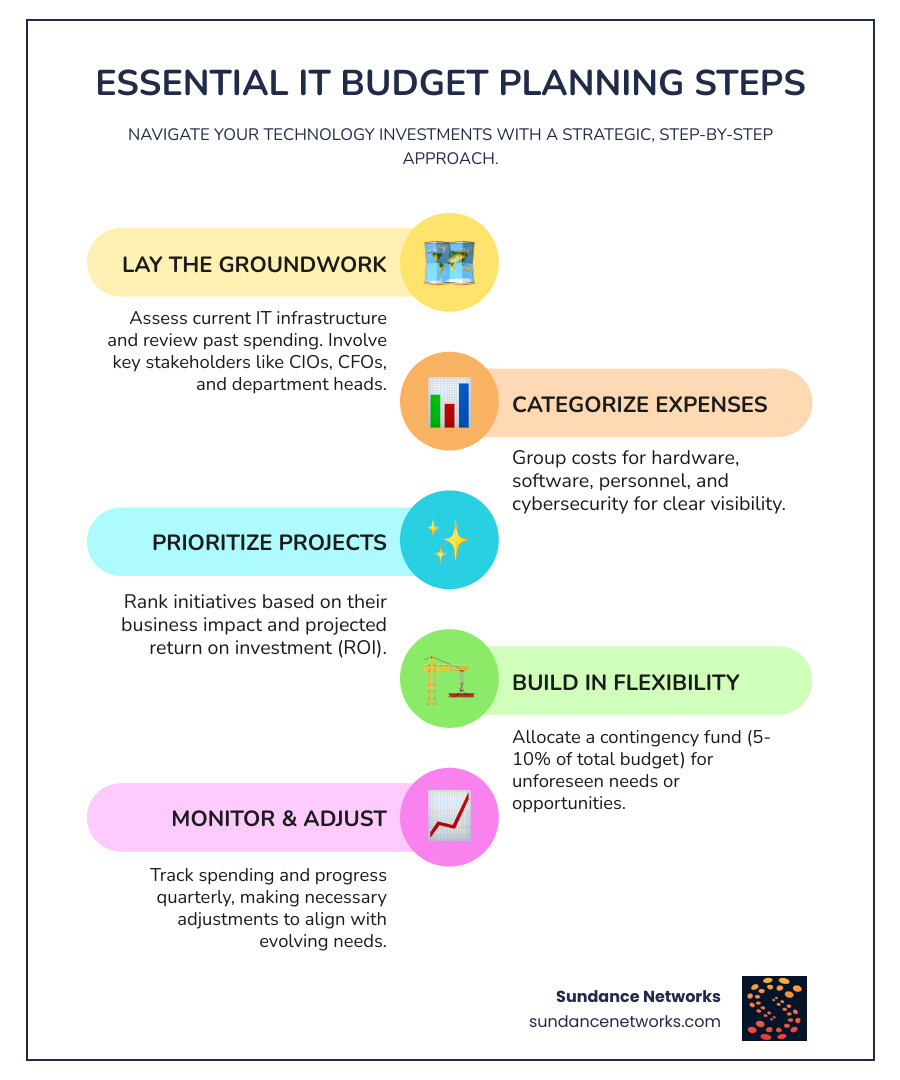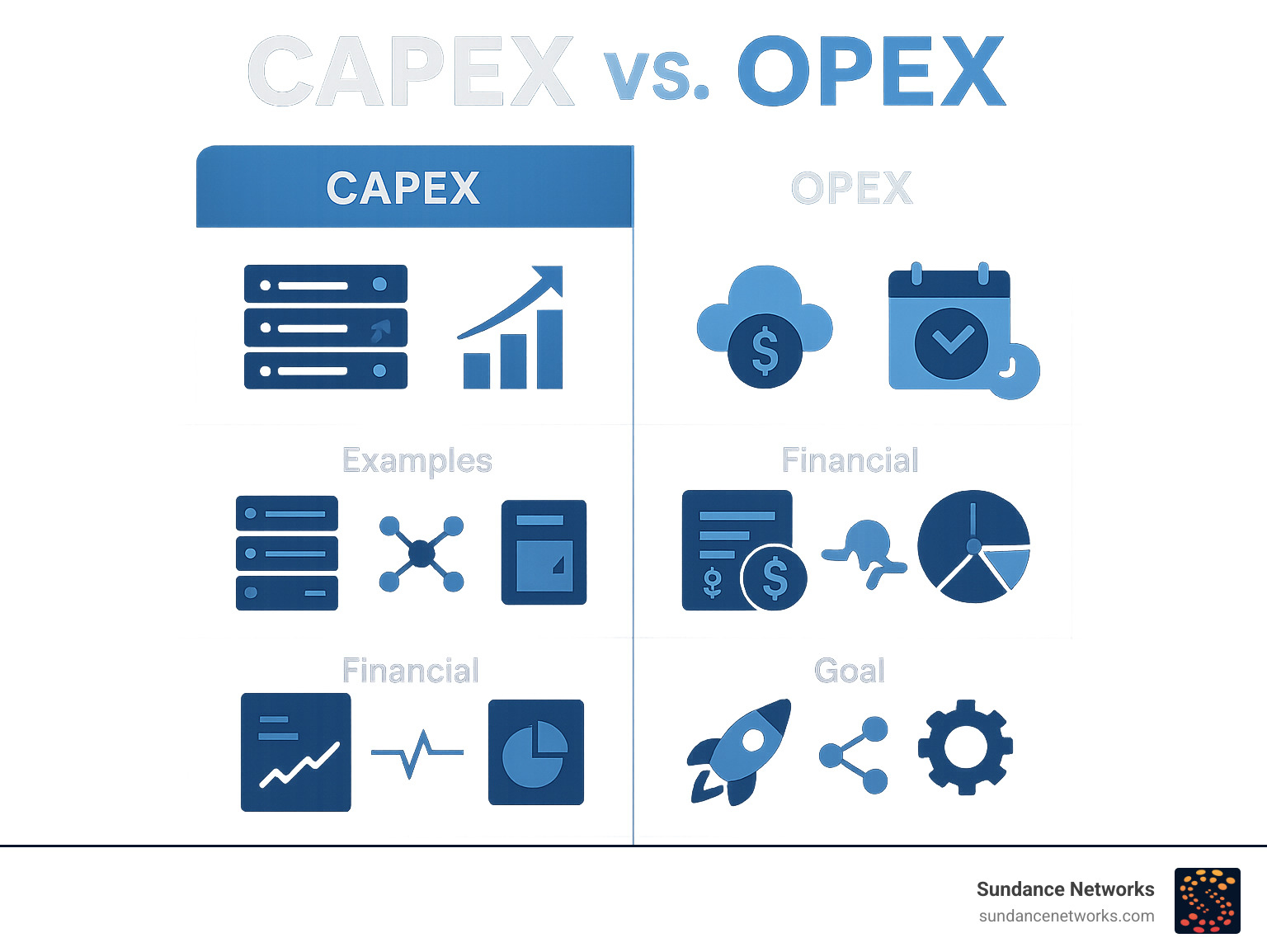
IT budget planning is your roadmap to technology success. Without it, you’re driving blind in a digital world where mistakes are costly.
Essential IT Budget Planning Steps:
- Assess current IT infrastructure and review past spending
- Involve key stakeholders (CIO, CFO, department heads)
- Categorize expenses into hardware, software, personnel, and security
- Prioritize projects based on business impact and ROI
- Build in flexibility with contingency funds (5-10% of total budget)
- Monitor and adjust quarterly throughout the year
With worldwide IT spending projected to reach $5 trillion in 2024, effective IT budget planning provides a massive competitive advantage. Poor planning leads to cost overruns, security gaps, and outdated technology that can’t keep pace with business needs.
Smart IT budget planning isn’t just about controlling costs – it’s about strategically investing in your company’s digital future.
55% of companies plan to increase IT spending, but many lack a clear strategy. Whether your budget is 2.3% of revenue (manufacturing) or 8.6% (financial services), every dollar must be optimized.
Your IT budget impacts everything from operations to innovation. A solid budget funds growth, protects data, and maintains a competitive edge. A poor one leads to system failures when you need them most.

Understanding the Core of Your IT Budget
IT budget planning can feel complex, but understanding its core components makes it manageable. Think of it as the financial blueprint for your company’s digital operations.
What Are the Key Components of an IT Budget?
Your IT budget is made up of several distinct categories, each vital for a healthy technology ecosystem.
Hardware costs cover physical assets like servers, laptops, and networking gear. Plan for regular refresh cycles (e.g., 3-5 years for PCs) to avoid using inefficient and vulnerable equipment. Our Essential IT Hardware Solutions can guide your choices.
Software licenses and subscriptions include operating systems, productivity suites (e.g., Microsoft 365), and SaaS applications. Track usage carefully to eliminate paying for unused licenses, a common source of waste.
Personnel and staffing costs are often the largest budget portion, covering salaries, benefits, training, and fees for internal staff or external consultants. Outsourcing can be a cost-effective alternative for specialized skills.
Cloud services encompass IaaS, PaaS, and SaaS costs for cloud storage, computing, and hosted applications. Understanding these models is key for accurate forecasting. Our guide on On-Premise vs. Cloud: Choosing Your IT Infrastructure can help.
Cybersecurity measures are essential, non-negotiable costs for firewalls, antivirus, MFA, training, and incident response tools. A robust strategy requires funding for prevention, detection, and response. Our Comprehensive Cyber Security Services can help build your defenses.
Maintenance and support contracts are recurring costs for hardware support, software updates, and patch management. These are crucial for system stability and avoiding downtime.
IT projects and innovation is funding for strategic initiatives like system upgrades, new software, and exploring emerging tech. These investments drive growth and efficiency.
Disaster recovery and data backup solutions protect your business from data loss due to hardware failure, disasters, or cyberattacks. This includes backup systems and continuity planning. Our Disaster Recovery & Data Backup Solutions ensure you’re prepared.
Contingency funds are a crucial buffer (5-10% of the total budget) for unexpected expenses, emergency repairs, or strategic opportunities.
Capital Expenditures (CapEx) vs. Operational Expenditures (OpEx)
Understanding CapEx vs. OpEx is crucial for technology investment strategy, impacting cash flow and taxes.
Capital Expenditures (CapEx) are large, long-term investments in assets like servers or perpetual software licenses that are depreciated over time.
Operational Expenditures (OpEx) are ongoing, day-to-day costs like SaaS subscriptions, cloud hosting fees, and IT salaries that are expensed as they occur.
| CapEx Examples | OpEx Examples |
|---|---|
| Server purchases, network equipment, perpetual software licenses, data center build-outs | SaaS subscriptions, cloud hosting, support contracts, IT salaries, utilities |

The shift to cloud and SaaS has increased OpEx spending, offering flexibility and scalability. The key is to find the right CapEx/OpEx balance to support current operations and future growth.
Why is IT Budgeting Crucial for Business Success?
Strategic IT budget planning is about more than controlling costs; it’s about positioning your business for success.
- Operational continuity: Proper funding for maintenance and support prevents costly downtime.
- Aligning technology with business goals: Ensures IT spending directly supports strategic objectives.
- Cost control and optimization: A clear budget helps identify overspending and reallocate resources for maximum impact.
- IT asset lifecycle management: Facilitates planned purchasing, maintenance, and replacement of technology, avoiding surprise expenses.
- Strategic initiatives and digital change: Provides the necessary funding for innovation and projects that drive growth.
- Performance tracking and accountability: Creates a baseline to monitor performance and demonstrate the value of IT investments.
The Strategic IT Budget Planning Process: A Step-by-Step Guide

Approaching IT budgeting systematically turns a painful process into a powerful tool for strategic decision-making. Here’s a step-by-step guide to building a comprehensive IT budget.
Step 1: Laying the Groundwork for Your IT Budget Planning
This initial phase is about understanding your current state to set the stage for future planning.
- Assess Current IT Infrastructure: Inventory all hardware, software, and contracts to understand their age, performance, and end-of-life. A formal IT audit can identify gaps, risks, and pressing needs.
- Review Past Spending and Budgets: Analyze last year’s budget versus actual spending to identify trends, unexpected costs, and areas for optimization, such as unused software licenses.
- Involve Key Stakeholders (CIO, CFO, Department Heads): Collaborate with leaders across the business. IT provides technical insight, Finance offers financial oversight, and department heads know operational needs. This ensures alignment and buy-in. Our Custom IT Consulting & System Integration can facilitate these conversations.
- Define Overarching Business Objectives: Clarify what the business aims to achieve in the upcoming period. Your IT budget must directly support these goals, whether it’s market expansion, a new product launch, or improved customer experience.
Step 2: Forecasting Costs and Identifying Needs
Translate your objectives into concrete financial requirements.
- Estimate Hardware and Software Costs: Project costs for new purchases, upgrades, and replacements based on your assessment and business goals. Research market prices and include associated costs like installation and training.
- Calculate Personnel and Training Expenses: Project salaries, benefits, and any planned hiring or outsourcing costs. Allocate funds for training to keep your team’s skills current with new technologies and threats.
- Factor in Maintenance and Support Renewals: List all recurring contracts and account for any anticipated cost changes to avoid surprises.
- Project Costs for New Initiatives: Estimate all costs for planned projects (e.g., AI adoption, system upgrades), including hardware, software, and personnel. Prioritize based on strategic alignment and ROI.
- Identify Potential Savings and Efficiencies: Look for ways to optimize spending, such as consolidating vendors, negotiating rates, or eliminating unused software licenses.
- Consider Business Growth Projections: Ensure your IT budget scales with the business. Plan for increased licenses, bandwidth, or server capacity to support anticipated growth.
Step 3: Drafting, Prioritizing, and Refining
This phase involves allocating funds, prioritizing needs, and getting critical feedback.
- Categorize Expenses (Run, Grow, Transform): Categorize expenses into three strategic buckets to guide allocation: Run (essential operations), Grow (upgrading capabilities), and Transform (disruptive innovation). This framework ensures core operations aren’t compromised while funding future growth.
- Prioritize Projects Based on ROI and Strategic Importance: Rank projects by potential ROI, strategic alignment, and urgency to ensure the most impactful initiatives receive funding.
- Draft the Initial Budget Proposal: Compile all estimates into a clear, concise document that is easily understood by non-technical stakeholders.
- Review with Stakeholders for Feedback and Buy-in: Present the draft to key stakeholders to gain consensus. Be prepared to justify requests with data and explain the business impact of funding decisions.
- Refine and Adjust Based on Collaborative Input: Incorporate stakeholder feedback in an iterative process to create a final budget that is realistic, comprehensive, and has full buy-in.
Step 4: Finalizing and Implementing the Budget
This final phase translates your planning into effective execution.
- Secure Final Approval from Leadership: Submit the refined budget to executive leadership and finance for final approval and spending authorization.
- Communicate the Finalized Budget to Relevant Teams: Share the approved budget, spending guidelines, and reporting requirements with all involved teams to ensure transparency and accountability.
- Establish Monitoring and Tracking Systems: Implement processes to monitor expenses throughout the year. Regularly compare actual spending against the budget to make timely adjustments.
- Use a free budget calculator spreadsheet for detailed tracking. Leverage tools to track technology spending. Many IT budget templates are available to help categorize spending for better predictability.
Best Practices and Common Pitfalls
Success in budgeting lies in adhering to best practices and avoiding common missteps. This section is your safety net, offering lessons that can save you time, money, and headaches.
Best Practices for Strategic IT Budget Planning

At Sundance Networks, we’ve seen what makes IT budget planning work in the real world.
Align with business goals. Your IT budget is the financial backbone of your business strategy. Every dollar should connect to a business objective, whether it’s market expansion or improving customer experience.
Build in flexibility. The only constant in IT is change. A contingency fund of 5-10% is not waste; it’s strategic insurance against shifting market conditions, new threats, and unexpected opportunities.
Leverage data and analytics. Use historical spending data, usage metrics, and ROI calculations to justify investments and move from guesswork to a data-driven strategy. Our Calculate Your AI Impact tool can help quantify potential investments.
Communicate transparently. Avoid technical jargon. Explain IT investments in terms of business impact to get buy-in from non-technical stakeholders like the CFO. Communicate your IT strategy early to build consensus.
Review and adjust regularly. Treat your budget as a living document. Business priorities and market conditions change, so regular reviews (e.g., quarterly) are essential to stay aligned and effective.
Focus on Total Cost of Ownership (TCO). Look beyond the initial purchase price. Factor in long-term costs like training, support, and integration. The cheapest upfront option is often more expensive over its lifetime.
Common Mistakes to Avoid
Learning from others’ mistakes is cheaper than making your own. Here are the budget killers we see repeatedly.
Insufficient communication between IT and finance. When these teams don’t collaborate, budgets fail. IT proposals may lack financial context, and finance may cut critical tech spending. Ensure they work together from the start.
Neglecting ongoing maintenance and upgrades. Skipping maintenance saves money short-term but leads to higher costs, security risks, and productivity loss later. Budget for routine upkeep to ensure system health.
Overlooking cybersecurity costs and emerging cybersecurity threats. Underfunding security is a major risk. With threats constantly evolving, yesterday’s defenses are inadequate. The question isn’t if you can afford robust cybersecurity, but if you can afford a breach.
Having no contingency fund. Without a buffer, unexpected hardware failures or security patches become crises, forcing poor, costly decisions. A contingency fund handles normal IT unpredictability.
Rigidly adhering to the budget without room for adjustment. A rigid budget stifles innovation and agility. Build flexibility into your process to pivot when markets change, threats emerge, or opportunities arise.
Underfunding staff training. New technology is useless without trained staff. Underfunding training leads to poor adoption, user frustration, and a low ROI. A team’s skills are as critical as the systems they use.
The truth is, most budget problems aren’t about money – they’re about planning, communication, and flexibility. Get these fundamentals right, and your IT budget planning becomes a strategic advantage instead of an annual headache.
Frequently Asked Questions about IT Budgeting
We get a lot of questions from clients about IT budget planning. It’s an area where even experienced leaders can feel uncertain. Let’s tackle the most common questions we hear.
How often should an IT budget be reviewed?
While IT budgets are typically created annually to align with the fiscal year, they shouldn’t be static. The nature of technology, with its shifting business priorities and emerging security threats, demands more frequent attention.
Best practice is to review your budget regularly—at least quarterly. For companies in high-growth phases or undergoing significant digital change, monthly reviews may be more appropriate. These regular check-ins ensure your spending remains aligned with business goals and allow you to stay agile, adapting to new challenges and opportunities.
Who controls the IT budget?
Control of the IT budget is a collaborative effort. The process is typically led by the Chief Information Officer (CIO), who works closely with the Chief Financial Officer (CFO), IT managers, and department heads.
Each stakeholder provides a critical perspective: the CIO offers technical expertise, the CFO ensures financial alignment, and department heads voice operational needs. While the CIO often drafts and defends the budget, final approval rests with executive leadership and the finance department. The most effective budgets result from a strong partnership between IT and Finance, ensuring the plan is both technically sound and financially responsible.
How much of an IT budget should go to security?
There is no single magic number for security spending, as it depends heavily on your industry, risk profile, and regulatory requirements. For example, a financial services firm (which may spend 8.6% of revenue on IT) will have a larger security budget than a manufacturing company (around 2.3% of revenue on IT).
However, security spending is universally increasing due to more sophisticated cyberattacks. A recent Gartner survey indicates a trend toward smarter spending through vendor consolidation.
The key is to allocate sufficient funds across three critical areas: proactive defense, threat detection, and incident response. A thorough risk assessment with an IT security partner can help determine the right investment level for your business, as the cost of prevention is far less than the cost of a breach.
Conclusion
We’ve covered a lot of ground today, and if there’s one thing we hope you take away, it’s this: IT budget planning isn’t just about crunching numbers or keeping the CFO happy. It’s your strategic roadmap to technology success.
Think of it this way – every successful business has a plan for where their money goes. Your IT budget is that plan for technology. It’s how you ensure every dollar spent on hardware, software, and security actually moves your business forward instead of just keeping the lights on.
The best IT budgets share three key traits: they align perfectly with business goals, they build in flexibility for the unexpected, and they rely on real data to guide decisions. When you nail these fundamentals, something magical happens. Your technology transforms from a necessary expense into a competitive advantage.
This isn’t a “set it and forget it” process. The most successful organizations treat their IT budgets as living documents that evolve with their business needs. They review regularly, adjust when necessary, and always keep their eyes on the bigger picture.
A well-planned IT budget is an investment in your company’s future – not just its efficiency and security, but its ability to grow and adapt in an increasingly digital world. It’s about being proactive rather than reactive, strategic rather than scattered.
At Sundance Networks, we’ve seen how the right technology strategy, backed by smart financial planning, can transform businesses. We specialize in empowering businesses of all sizes across diverse sectors with smart technology, scalable AI, and robust security.
For expert guidance in aligning your technology strategy with your financial planning, explore our Managed IT Services & Security Solutions. Because when it comes to your digital future, you shouldn’t have to figure it out alone.


